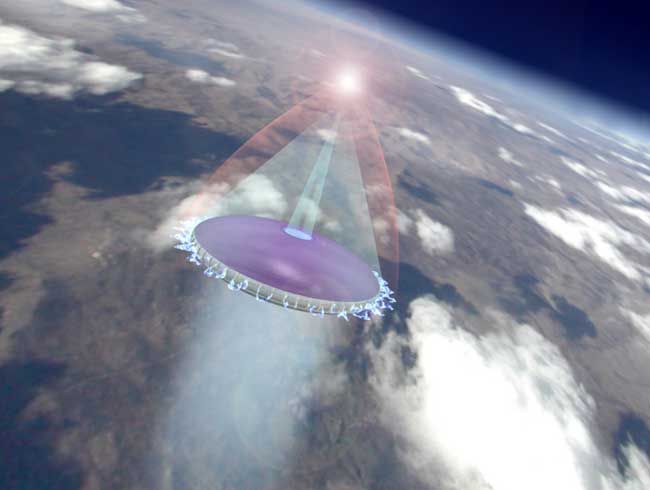TL;DR: flight is very energy intensive, and you'll have to build a lot of power stations and then build a vast and expensive network of directed energy weapons and persuade travellers that having you shoot at them is a good thing.
It is a little bit hard to pin down exactly how much power is required to keep an airliner in the air, but this KLM blog post suggests that a Boeing 777 produces about 23MW at cruising altitude. Takeoff is significantly more energy intensive, but lets imagine there's some other solution to that problem.
This link suggests that there are 8000-20000 aircraft in the air at any given time, though of course most of these won't be airliners. If we assume that there are, say, 5000 airliners in the air, and each needs 20MW of power, that's a nice round 100GW of received power. High energy microwave production isn't the most efficient thing in the world, but a nice gyrotron maser should manage at least a 50% efficiency, so including transmission losses of 20% that's a total required generating power of 240GW. The USA in 2017 had a total installed summer generating capacity of 1072GW, and the total world grid supply in 2014 was about 6142GW, so you can see that this is a non-trivial amount of power to handle (and that 240GW is a super-ultra optimistic total best case, by the way. It'll be much, much higher, see below).
I'm not going to try and estimate the number of ground stations you'd need, or the power switching capacity you'd need to feed them. You'll need to lay them out along flight paths so they won't be completely evenly distributed, so they can at least have their own purpose built power supply lines, which will of course need to be redundant because they are safety critical systems, but maybe someone else will consider this issue and let you know how inconvenient it will be (I'm guessing somewhere between "quite" and "very").
Next up is power density at the target.
A Boeing 777 has a wing area of about 428m2. If you cover that with your microwave rectennae, you need to be delivering ~47kW/m2. In the US, occupational safety limits for microwave radiation are ~10mW/cm2. Proposed microwave solar power sats would be limited to a peak intensity of 23mW/cm2. Your beams are ~470x more intense that the OSHA limit, and ~200x more intense than the powersat design. There are some serious risk assessements required in there, I think you'll find! This is also the best-case scenario where the plane is being zapped from directly below it (in level flight). As the beam angle with vertical increases (because the plane is flying away from the emitter) the power density will necessarily have to increase to the point where it starts looking like an energy weapon, not a power supply. More ground stations can reduce this problem, but vastly increase cost and complexity of the system.
This also assumes that all the emitted energy is absorbed by the rectenna grids, of course. in practise, you'll have pointing errors, so you'll need to be producing a much higher energy beam that fully encompasses the silhouette of the target aircraft, so you'll be illuminating the fuselage (often filled with meaty cargo) and wasting masses of power that simply misses any rectenna and flies off into space, substantially increasing the power requirements of the ground stations. I'm not going to estimate how much, because phased array pointing accuracies and diffraction shapes are fiddly to work with, but I'm going to say that it will at least double the power requirements, and will probably require much more juice than that.





